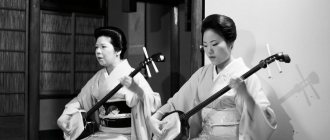Folk musical instruments in Japan were and are used to accompany the singing of Buddhist parables and war tales, as an invariable attribute of aristocratic education and pastime, they were used by Zen masters to perform meditative melodies. National musical instruments in Japan are widely known and loved. The popularity is due not only to the Japanese people’s respect for their culture and history, but also to the use of national instruments in traditional Japanese theater - primarily in Kabuki and Bunraku theater and even in modern art.
Biwa
Biwa (Japanese: 琵琶) is a national Japanese instrument . The term biwa covers a number of Japanese musical instruments of the lute family. In Japan, two varieties of biwa have long been widespread (mentioned in written sources of the 8th century) - gakubiwa and gogenbiwa .
The gakubiwa is a pear-shaped instrument with a short neck on which 4 frets are located, and a head bent back, equipped with four pegs for tuning four silk strings. The tuning is consistent with the six modes of classical Japanese gagaku music. Length - 122 cm, width - 41 cm. The sound is produced using a plectrum (18 cm), to protect the soundboard from impacts of the plectrum, a wide leather tape, usually black, is glued across its central part.
Subsequently, a number of new varieties of biwa ( sasabiva, heikebiwa, satsumabiva ) arose, used to accompany the singing of Buddhist parables and war tales. In the 19th century, the last variety of this type of instrument appeared - chikuzenbiwa .
How to play the shamisen
A distinctive feature of the instrument is the ability to change the timbre. The main way to produce sound is to strike the strings with a plectrum. But, if the performer simultaneously plucks the strings on the fingerboard with his left hand, the sound becomes more elegant. The lower string of the sawari is important in the performing arts. Plucking it allows you to extract a spectrum of overtones and light noise that enriches the melody. In this case, the line of the narrator’s or singer’s voice should coincide as much as possible with the sound of the syami, slightly ahead of the melody.
Shamisen is not just a musical instrument; it embodies centuries-old traditions, the history of Japan, and the cultural values of the people. Its sound accompanies the inhabitants of the country from birth to death, giving joy and sympathetically melodic in sad periods.
Koto
Koto (Japanese 琴) or Japanese zither is a Japanese plucked musical instrument . The koto, along with the hayashi and shakuhachi , the tsuzumi and the shamisen lute, is a traditional Japanese musical instrument.
Similar instruments are typical for the culture of Korea (Gayageum) and China (Qixianqin).
The history of the koto as a Japanese musical instrument dates back more than a thousand years. It was introduced to Japan from China during the Nara period (710–793 CE) as an instrument for the palace orchestra and was used in gagaku (雅楽) music. Koto its peak in the Heian era, as an invariable attribute of aristocratic education and pastime. One of the most famous pieces written specifically for koto is the composition “Rokudan no Shirabe” (六段の調べ, “Music of the Six Steps”) created in the 17th century by the blind master Yatsuhashi Kengyo. The koto is played using false nail picks ( kotozume , Japanese 琴爪), placed on the thumb, index and middle fingers of the right hand. Modes and keys are adjusted using string bridges immediately before playing. Playing the koto is one of the traditional Japanese national arts, which became widespread primarily at the imperial court. However, even today this instrument is very popular. Thanks to its plasticity , koto finds application in modern Japanese music and contributes to its development.
Symbols of Japanese culture
The first association with Japan is sakura (Japanese cherry). The country has a special ceremony for admiring its blossoms - hanami. The tree is repeatedly sung in Japanese haiku poems. Japanese folk songs reflect the similarity of natural phenomena with human life.
Not inferior in popularity to sakura, the crane is a symbol of happiness and longevity. It is not for nothing that the Japanese art of origami (folding paper shapes) has become popular all over the world. Making a crane means attracting good luck. The image of a crane is present in many Japanese songs. Other symbols are also taken from the surrounding world. The symbolism of Japanese culture is natural symbolism.
Shakuhachi
Shakuhachi (Japanese: 尺八) is a longitudinal bamboo flute that came to Japan from China during the Nara period. The Chinese name for the flute is xiao (dongxiao).
Today there are about twenty varieties of shakuhachi. The standard flute length is 1.8 Japanese feet (which is 54.5 cm). This determined the very Japanese name of the instrument, since “shaku” means “foot” and “hachi” means “eight”. The instrument has a special, unique sound, which can vary significantly at the request of the player playing the melody. This property was used by Zen masters to perform meditative melodies (the practice of suizen). In addition, the flute was widespread among peasants, as it was an easy-to-make instrument and was suitable for performing folk melodies.
In design and sound production the shakuhachi is similar to the Andean kena: to produce sound, the musician places the upper end of the flute to his lips and directs the air flow to the wedge.
Currently, it is customary to distinguish three main schools (styles) of playing the shakuhachi: tozan (tozan-ryu, Japanese 都山流), founded by Nakao Tozan (1876-1956), kinko (kinko-ryu, named after the founder Kurosawa Kinko ( 1710-1771) Japanese 琴古流), and Myoan (Myoan-ryu, Japanese 明暗流), associated with Myoanji Temple in Kyoto. It was formed immediately after the dispersal of the Fuke sect in order to continue the tradition of honkyoku. Its founder is considered to be Ozaki Shinryu (1820-1888).
Suikinkutsu
Rounding out the seven most interesting and original instruments in Japan is a very unusual instrument. Previously, anyone could play on it by going to the nearest well.
The secret was simple: a jug made of ceramics, clay or metal was buried in the ground at the bottom of the well, having first turned it over. The bottom of the jug had a hole through which water seeped and poured out into pleasant sounds.
Singing Well Suikinkutsu
Today, the likenesses of the ancient suikinkutsu are more compact. You can enjoy this melody in modern squares, shops and even houses.
Shamisen
Shamisen (Japanese 三味線 lit. “three strings”), also sangen; outdated shamizen, shamisen) is a Japanese three-stringed plucked musical instrument . The closest European analogue of the shamisen is the lute. The shamisen, along with the hayashi and shakuhachi flutes, the tsuzumi drum and the koto zither, is one of the traditional Japanese musical instruments.
Shamisen appeared in Japan around the 15th-16th centuries. The predecessor of the shamisen is the sanshin (三線), which was played in the Ryukyu Kingdom, which at that time became a prefecture. Sanxing , in turn, is derived from the Chinese instrument sansian , which originated from Central Asian instruments. Unlike Europe, where traditional/antique instruments do not receive much attention, the shamisen and other traditional instruments in Japan are widely known and loved. The popularity is due not only to the respect of the Japanese for their culture and history, but also to the use of national instruments, in particular the shamisen, in traditional Japanese theater - primarily in the Kabuki and Bunraku theater. Learning to play the shamisen is included in the training program for maiko - future geishas.
The shamisen was also an essential instrument for the traveling blind goze who emerged early in the Tokugawa shogunate.
There are several types of instruments that differ from each other in the thickness of the neck. Instruments with a narrow neck are called hosozao (細棹) and are used primarily in nagauta (長唄) music. An instrument with a medium-thick neck is called chuzao (中棹) and is used in such musical genres as kiyomoto (清元), tokiwazu (常磐津), jiuta (地唄), etc. In northern Japan, especially in the Tsugaru region (western part of Aomori Prefecture) a separate type of shamisen with a thick fingerboard, tsugaru-jamisen (津軽三味線), is used, the playing of which requires special virtuosity. The thickest tsugaru-jamisen futozao (太棹) and is used in joruri (浄瑠璃). Shamisen is made from hardwood (mahogany is used to make expensive instruments). The body is covered with cat (in Tsugarujamisen - dog) skin. The shamisen is played with a large “bati” plectrum, which is made from materials such as wood, ivory, tortoise shell, buffalo horn, and plastic. Bati for nagaut and dziut are almost regular triangles, with very sharp edges. Tsugarujamisen suggests a smaller plectrum, more reminiscent of a ginkgo tree leaf. Strings are made from silk, nylon and tetlon. Learning to play the shamisen in the style of kouta (小唄) “short song” is included in the training program for maiko - future geishas. The name contrasts with the genre of bunraku and kabuki music, nagauta (長唄) (long song). The best known and most complex of the performance styles is gidayu , named after Takemoto Gidayu (1651-1714), a figure in the bunraku puppet theater from Osaka. The gidayu instrument and plectrum are the largest, and the gidayu himself is both a singer and a commentator on what is happening on stage. The storyteller's work is so complex that in the middle of the performance the guidayu changes. The narrator must know the text and melody absolutely precisely. , onna-gidayu, female storytellers, also appeared .
Main song and dance genres
Like other nations, Japanese folk music has undergone an evolution from ancient magical forms to secular genres. The formation of most of them was influenced by Buddhist and Confucian teachings. The main classification of Japanese music genres:
- religious music,
- theater music,
- Gagaku court music
- folk everyday songs.
The most ancient genres are considered to be Buddhist chants of shomyo and court music of gagaku. Topics of religious chants: Buddhist doctrine (kada), tenets of teaching (rongi), pilgrimage hymns (goeika), songs of praise (vasan). Shinto music is music to please the gods, short cycles of songs and dances in costumes.
The secular genre includes court orchestral music. Gagaku is an ensemble borrowed from China that performs instrumental (kangen), dance (bugaku) and vocal (uachimono) music.
Japanese folk dances have their origins in ritual performances. The dance involves strange, sudden movements of the arms and legs, and the dancers are characterized by twisted facial expressions. All movements are symbolic and understandable only to initiates.
There are two types of modern Japanese dance: odori, an everyday dance with sharp movements and jumps, and mai, a more lyrical dance that represents a special prayer. The odori style gave rise to kabuki dance, and subsequently the world-famous theater. The Mai style formed the basis of Noh theater.
About 90% of the music of the Land of the Rising Sun is vocal. Important genres of folk music are folk tales, songs accompanied by koto, shamisen and ensembles, and ritual folk songs: wedding, work, holiday, and children's.
The most famous Japanese folk song is the song “Sakura” (that is, “Cherry”):
DOWNLOAD NOTES -
Use in modern music
Shamisen, due to its specific sound, is often used to enhance the “national” sound in some Japanese films and anime (much like the balalaika in Russia). Thus, shamisen sounds in the soundtrack of the anime series Naruto, Puni Puni Poemi. Agatsuma Hiromitsu plays in the New Age style. It is used by representatives of the European musical avant-garde (for example, Henri Pousseur). The compositions performed by the Yoshida Brothers are quite popular; their shamisen sounds like an electric guitar. Michiro Sato performs improvisations on the shamisen, and jazz pianist Glenn Horiuchi inserted fragments of shamisen playing into his compositions. Guitarist Kevin Kmetz leads the Californian band "God of Shamisen", in which he plays the Tsugaru-jamisen. The Yoshida brothers perform music in the traditional northern Japanese style of Tsugaru-jamisen with the addition of drums and synthesizers.
Hitirik
Another wind instrument is also very similar to a small flute. It is made of wood: a bamboo tube and an external decoration of cherry bark.
Hichiriki
The sound range corresponds to the dimensions - only an octave. Music is extracted from special holes. In addition, the hitirik is equipped with a ring that allows you to vary the tonality and sound.
Tool structure
Over the long period of its existence, the design has not actually changed. For production, paulownia, a common tree in the east, is used. It is the quality wood and the skill of the carver that determine the beauty of the Japanese koto. Surfaces are usually not decorated with additional ornaments.
The length reaches 190 cm, the width of the deck is usually 24 cm. The instrument is quite massive and has serious weight. Most varieties are placed on the floor, but some can be placed on your lap.
Interestingly, the Japanese associated the deku with traditional mythology and religious ideas, thereby giving it an animated quality. The soundboard is compared to a dragon lying on the shore. Almost every part has its own name: the top is associated with the dragon’s shell, the bottom with its belly.
The strings have a unique name. The first strings are counted in order, the last three strings are named virtues from Confucian teachings. In ancient times, strings were made of silk; now musicians play with nylon or polyester-viscose strings.
There are holes made in the soundboard, making it easy to change strings and improving sound resonance. Their shape depends on the type of koto.
To extract sound, special tsume mediators made from elephant tusk are used. The attachments are put on the fingers. With their help, a rich and juicy sound is produced.








